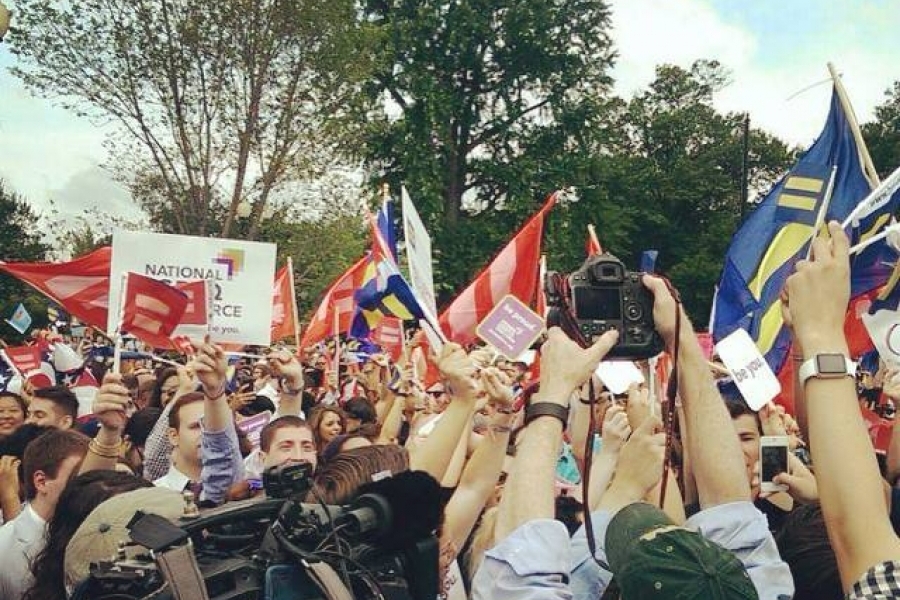Marriage equality is now a nationwide reality.
In a landmark vote June 26, the U.S. Supreme Court found that the U.S. Constitution guarantees same-sex couples the right to marry.
The ruling immediately mandated marriage equality in the 13 states that had yet to sanction it and makes the United States the 21st country to fully allow same-sex marriage in all jurisdictions.
The 5-4 opinion was written by Justice Anthony Kennedy, who wrote that denying same-sex couples marriage rights constitutes “a grave and continuing harm.”
“The imposition of this disability on gays and lesbians serves to disrespect and subordinate them,” he continued. “And the Equal Protection Clause, like the Due Process Clause, prohibits this unjustified infringement of the fundamental right to marry.”
Joining Kennedy was Justices Ruth Bader Ginsberg, Sonia Sotomayor, Stephen Breyer and Elena Kagan. Dissenting was Chief Justice John Roberts and Justices Samuel Alito and Clarence Thomas and Antonin Scalia, who wrote the scathing dissent calling the decision a “threat to American democracy.”
Path to SCOTUS
The ruling came in Obergefell v. Hodges, a challenge to Ohio’s ban on marriage equality that was consolidated with cases from Tennessee, Kentucky and Michigan. The four fell under the purview of the Sixth Circuit Court of Appeals, which upheld Ohio’s ban — dissenting with other federal appellate courts and giving SCOTUS the split it needed to finally act on the issue.
The ruling came two years to the day after SCOTUS issued another landmark ruling in a case brought by Philadelphia native Edie Windsor, which struck a key portion of the federal ban on same-sex marriage. That decision allowed same-sex couples who were legally married to access some federal benefits but left open the question of if states had the constitutional right to ban same-sex marriage. June 26 was also the day, 12 years ago, when SCOTUS ruled in Lawrence v. Texas, striking sodomy laws across the country. Kennedy also authored both of those opinions.
Pennsylvania became the 19th state to sanction marriage equality on May 20, 2014, when a federal judge overturned the state’s ban on same-sex marriage. A landslide of court decisions followed, bringing the total number of U.S. states with marriage equality to 37, plus Washington, D.C., prior to this week’s landmark ruling.
The states that had not yet sanctioned marriage equality prior to the SCOTUS ruling are: Arkansas, Georgia, Kentucky, Louisiana, Michigan, Mississippi, Missouri, North Dakota, South Dakota, Ohio, Tennessee, Texas and Nebraska.
The Williams Institute estimated that about 150,000 same-sex couples live in the states that had lacked marriage equality; the organization puts the total number of same-sex couples in the nation at about one million.
Local reaction
Outside the National Constitution Center Friday, a few LGBT-rights supporters milled about, one man carrying an American flag on his shoulder as he rode his bike in a circle and even former Gov. Ed Rendell made an appearance.
Immediately after the ruling the Center opened its doors for a Civic Gathering, inviting visitors to learn about the ruling through real-time updates and explore the “Speaking Out for Equality” exhibit free of charge.
The wording of one of the exhibit’s interactive displays was quickly changed Friday to “the Supreme Court will decide” to “the Supreme Court has decided,” and William Way LGBT Community Center archivist Bob Skiba said other updates will be made to ensure accuracy.
The exhibit coincides with the 50th anniversary of the Reminder Day protest, one of the nation’s first LGBT-rights demonstrations, held outside Independence Hall. The occasion will be marked with a number of anniversary activities new week, the timing of which Skiba said couldn’t be more perfect.
“I was doing a screening of ‘Gay Pioneers’ with the Environmental Protection Agency the other day and when it was over, I said to them that sadly most of the people talked about in the video are now dead. But I can’t image what they would think if they were here today,” Skiba said. “It’s important that the Supreme Court has been saying over the past couple years that this is all very new, we need to move cautiously. It’s not new; people have been working towards today for at least 50 years. It finally gained momentum but today we’re seeing the fruits of all that work over the last 50 years.”
The longevity of that fight was especially meaningful for Jerry Rineer, a Philadelphia resident who married his partner of 30 years in August in Pennsylvania.
“He sent me a text and said the Supreme Court made its ruling so I just had to come here,” he said about the Constitution Center. “It’s amazing. Now if we decide to retire and move, we go to any state and feel safe doing that.”
The ruling was also particularly meaningful for Richard Brannon. The 20-year-old Philadelphia resident moved here about a year-and-a-half ago from Georgia, one of the handful of states that had yet to sanction marriage equality before Friday.
“When I came to Philly, I had never really been an in environment that was this open before,” he said. “So any time something like this happens, I want to be where the action is, to celebrate.”
Brannon was also on hand for last year’s rally when Pennsylvania legalized same-sex marriage, which happened to come on his birthday. He said that, while he expected the nation to eventually follow suit, the reality of that happening is exhilarating.
“It’s not very shocking because I think most people felt like this was coming for a long time, but it’s still very reliving that this finally happened,” he said. “There are of course still a lot of issues that have to be tackled in the LGBT community — marriage isn’t the final stopping point — but it’s still very exciting.”
That notion of continuing forward was shared by Bill Fedullo, 21, an intern with the American Civil Liberties Union of Pennsylvania, who followed the ruling’s release with his colleagues in their conference room.
“We’ve had this in Pennsylvania for a year now and that was really exciting when that happened but it’s nice that we can now extend this right to couples throughout the country,” he said. “It’s obviously not the end of the LGBT-rights movement, but it’s a pretty significant victory and it’s good that our country is finally recognizing the rights of LGBT couples.”

